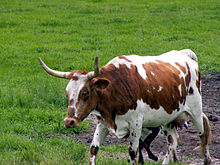
The Texas Longhorn is an American breed of beef cattle, characterized by its long horns, which can span more than 8 ft (2.4 m) from tip to tip. It derives from cattle brought from the Iberian Peninsula to the Americas by Spanish conquistadores from the time of the Second Voyage of Christopher Columbus until about 1512. For hundreds of years the cattle lived a semi-feral existence on the rangelands; they have a higher tolerance of heat and drought than most European breeds. It can be of any color or mix of colors. In some 40% of the cattle it is some shade of red, often a light red; the only shade of red not seen is the deep color typical of the Hereford.

The Galloway is a Scottish breed of beef cattle, named after the Galloway region of Scotland, where it originated during the seventeenth century.
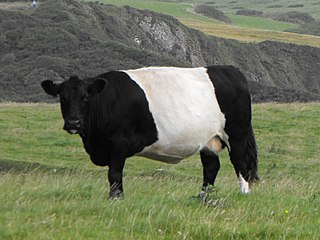
The Lakenvelder is a Dutch and German breed of dairy cattle. It is reported from the Netherlands and Belgium, but may be extinct in Germany.

The Dairy Shorthorn is a British breed of dairy cattle. It derives from the Shorthorn cattle of Teesside, in the North Riding of Yorkshire and in Northumbria in north-eastern England. The Shorthorn was for this reason at first known as the Durham or Teeswater.

The Dexter is an Irish breed of small cattle. It originated in the eighteenth century in County Kerry, in south-western Ireland, and appears to be named after a man named Dexter, who was factor of the estates of Lord Hawarden on Valentia Island. Until the second half of the nineteenth century it was considered a type within the Kerry breed.

The Corriente is an American breed of small cattle, used principally for rodeo events. It derives from Criollo Mexicano stock, which in turn descends from Iberian cattle brought to the Americas by the Conquistadores, and introduced in the sixteenth and seventeenth centuries to various parts of what is now Mexico.

The Belted Galloway is a traditional Scottish breed of beef cattle. It derives from the Galloway cattle of the Galloway region of south-western Scotland, and was established as a separate breed in 1921. It is adapted to living on the poor upland pastures and windswept moorlands of the region. The exact origin of the breed is unclear, although the white belt for which they are named, and which distinguishes the breed from black Galloway cattle, is often surmised to be the result of cross-breeding with the similarly-coloured Dutch Lakenvelder breed.

The Gir or Gyr is an Indian breed of zebuine cattle. It originated in the Kathiawar peninsula in the state of Gujarat, and the name of the breed derives from that of the Gir Hills in that region. Other names include Bhodah, Desan, Gujarati, Kathiawari, Sorthi and Surti.
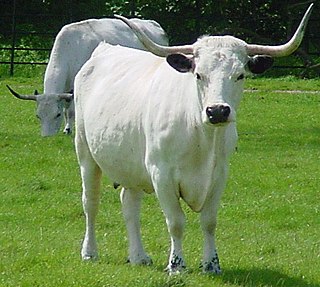
The White Park is a modern British breed of cattle. It was established in 1973 to include several herds or populations of colour-pointed white cattle – white-coated, with points of either red or black on the ears and feet. Such cattle have a long history in the British Isles, and the origins of some herds go back to the Middle Ages.

The American Milking Devon is an American breed of dual-purpose cattle, reared both for milk and for beef. It derives from the Devon cattle of the United States, which in turn are derived from the North Devon cattle of south-west England. It was established as a separate breed in 1978 with the formation of the American Milking Devon Cattle Association, after the breeding aims of the Devon were concentrated almost exclusively on beef production. It is a rare breed: its conservation status is listed as by the Livestock Conservancy as 'critical'.
The Tipo Carora or Carora is a Venezuelan breed of dairy cattle. It was bred in the early part of the twentieth century by crossing of local Criollo cows with imported Brown Swiss bulls. It is named for its place of origin, the town of Carora in the Venezuelan state of Lara.
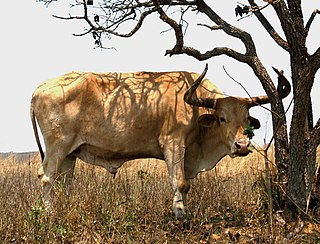
The Caracu is a Brazilian breed of beef cattle. It is a Criollo breed, derived from European cattle brought to Brazil by the conquistadors; it has little or no zebuine influence. It was originally a triple-purpose breed, used for draught work and transport, for meat and for milk; in the twenty-first century it is reared principally for beef, but there are also dairy lines. It has contributed to the development of a number of other breeds, among them the Caldeano. It is closely similar to the Mocho Nacional, a polled breed, and it is probable that the two will be merged.
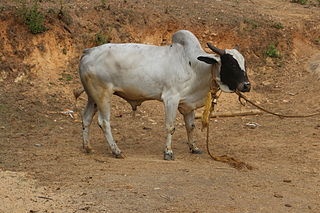
The Deoni is an Indian breed of draught cattle. It is named after the taluk of Deoni in the Latur district of Maharashtra state, and is distributed mainly in the Latur, Nanded, Osmanabad and Parbhani districts of the Marathwada region of Maharashtra, as well as the Bidar district of Karnataka.
The Lucerna is a Colombian breed of dual-purpose cattle. It is a composite breed, created in the twentieth century by cross-breeding local Criollo cattle of the Hartón breed with imported dairy cattle of European type. This was the earliest composite breed to be developed in South America.

The Finnish Ayrshire is a Finnish breed of dairy cattle. It derives from Scottish Ayrshire stock imported to Finland between about 1847 and 1923. It is the most numerous dairy breed of the country, constituting approximately 61% of the dairy herd.

The Mertolenga is a Portuguese breed of cattle. It is named for the concelho of Mértola in south-eastern Alentejo, bordering with Spain. In 2003 it was one of thirteen registered Portuguese cattle breeds, constituting approximately 19 per cent of cattle in the country.
Criollo is a group of cattle breeds descended from Iberian stock imported to the Americas, including among others

The Corse or Corsicana is a French breed of cattle indigenous to the island of Corsica.

The Dutch Belted or Dutch Belt is an American breed of dairy cattle. It derives from the Lakenvelder of Germany and the Netherlands, of which examples were imported to the United States from 1838. It became an important dairy breed in the early twentieth century, but could not compete with the Holstein-Friesian. By 1970 it was close to extinction; from 1993 the American Livestock Breeds Conservancy was active in the recovery of the breed. In 2021 it was listed as "critical" on the watchlist of the conservancy.
The Criollo Mexicano is a Mexican breed or group of breeds of Criollo cattle – that is, cattle that derive principally from the Iberian cattle brought to the Americas by the Conquistadores from the time of the Second Voyage of Christopher Columbus in 1493.


